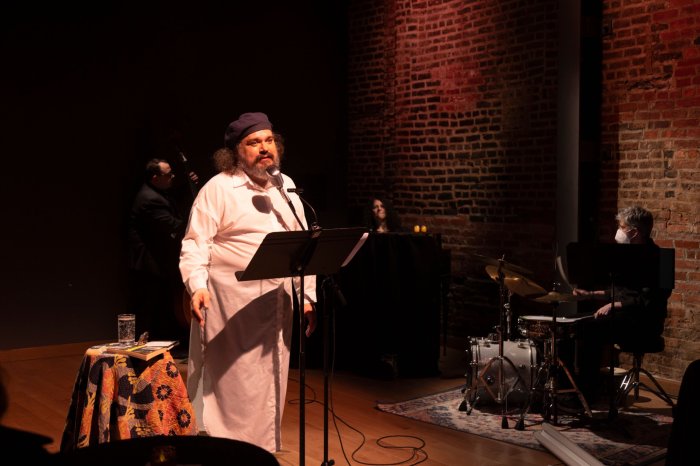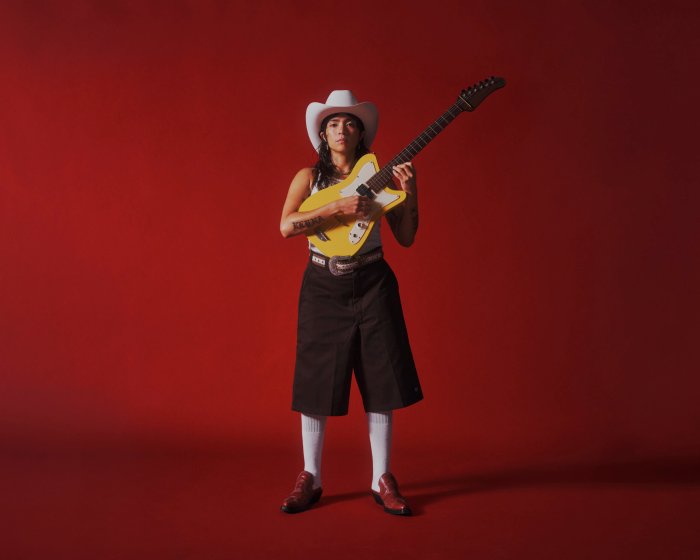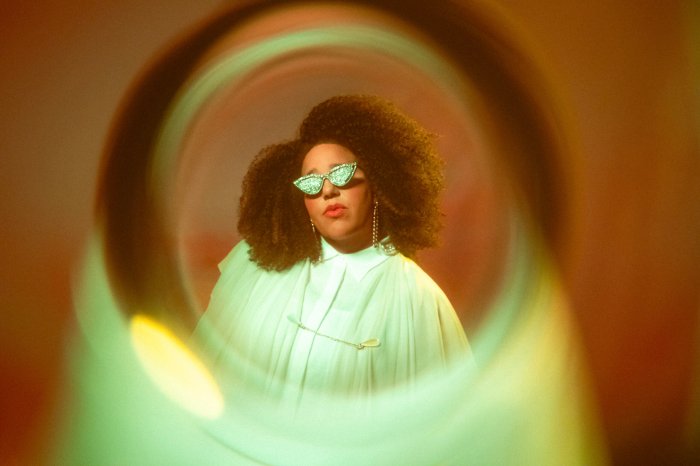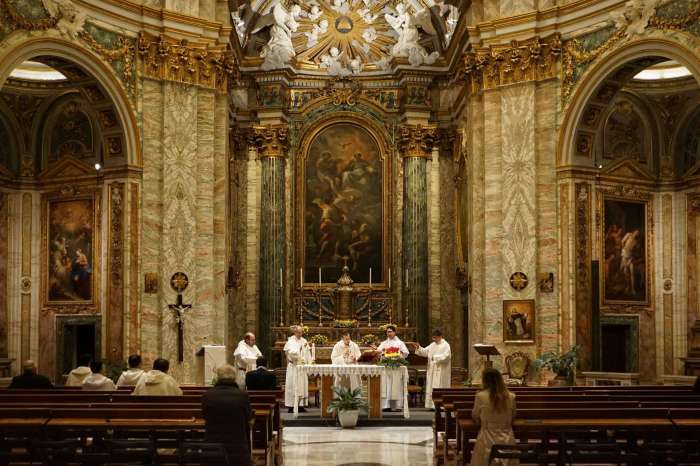Marc Molomot, Camille Zamora, and an immobile Kim Kardashian in On Site Opera's production of Jean Phillipe Ramaeu's “Pygmalion.” | PAVEL ANTONOV
BY ELI JACOBSON | With the mid-May end of the Metropolitan Opera’s season, opera is on the move throughout the city, springing up in museums, churches, concert halls, and parks. On Site Opera specializes in performing small-scale works in site-specific locations.
For Jean-Philippe Rameau’s 1748 one-act opéra-ballet “Pygmalion,” performances took place in two locations — Madame Tussauds New York and the Lifestyle-Trimco Showroom, a mannequin store. At the June 17 opening night performance at Madame Tussauds, just off Times Square, the opera was performed in the top floor rotunda, with a central faux-Venetian portico used as the proscenium performing area. Seating was arranged on either side of a fountain, while singers and dancers entered from the center aisle. Founder and stage director Eric Einhorn provided a bare-bones, modernized staging that could function in a variety of spaces.
The 45-minute piece, based on Ovid’s “Metamorphoses,” concerns the sculptor Pygmalion who has fallen in love with his creation, the statue Galatea, which is brought to life by Venus. Tenor Marc Molomot as Pygmalion was initially seen putting final touches on an effigy of actor Patrick Stewart, while a waxen yet bootylicious Kim Kardashian looked on. I was gripped by a horrifying thought — was La Kardashian perhaps engaging in another matrimonial adventure coinciding with an operatic debut? Fortunately, lovely Camille Zamora was wheeled onstage as Pygmalion’s beloved Galatea, upstaging Kardashian, who remained blessedly inanimate and silent.
Librettist Ballot de Savot added a romantic triangle to Ovid’s simple story — the disconsolate Céphise, who loves the hero but is rejected. Einhorn changed the original ending so that Pygmalion returns to Céphise and the statue reverts to inanimate solitude.
It was difficult to assess the musical quality of the performance because the open space lacked a resonant acoustic. I was told the musicians could not hear each other, let alone the singers. Still, conductor Jennifer Peterson presiding at the harpsichord maintained a polished ensemble performance from the New Vintage Baroque Orchestra (12 young Juilliard graduates performing a reduced orchestration).
Molomot’s weedy, unresonant tenor utilizes a stylistically correct but thin, disconnected falsetto top register. His failure to project I blamed on the acoustics until Emalie Savoy’s rich tones filled the space easily. Molomot seems more a character tenor in both appearance and vocal quality, despite careful French diction and flexibility in runs.
Savoy’s Céphise looked beautiful and sang movingly with a lusher, more rounded, easily produced tone than I have ever heard from her. Zamora has a beautiful stage face, an elegant figure, and a warm soprano with a mezzo coloration.
Brooklyn soprano Justine Aronson was a petite, piquant L’Amour. Dancers Eloise DeLuca and Jordan Isadore as “Jeux” and “Ris” (laughter and games) fooled this critic into thinking they were also statues. They maintained total immobility alongside a waxen George Clooney and Denzel Washington until they burst joyously into jazz-inflected contemporary choreography (by Isadore) that brought the evening to a festive close.
Gotham Chamber Opera also programmed a short work, the US premiere of Japanese composer Toshio Hosokawa’s monodrama setting of Edgar Allan Poe’s “The Raven.” It was performed three times in late May at the Gerald W. Lynch Theater at John Jay College as part of the New York Philharmonic’s Biennial.
Poe’s long narrative poem consists of 18 strophes with a recurrent final refrain of “Nevermore,” the internal rhymes and insistent rhythm being conducive to musical setting. Hosokawa’s arrangement for solo mezzo-soprano and chamber ensemble utilizes darkly shifting instrumental textures evocative of Schoenberg and Ligeti. Fragments of lyrical declamation are interrupted by spoken passages punctuated by percussion, reminding me of Kabuki.
The repeated refrain of “Nevermore” was set to different music each time, something illustrative of both the strengths and the weaknesses of Hosokawa’s piece. It always defies expectation and yet there is no overarching musical structure to coalesce the individually arresting musical passages into a memorable, coherent whole.
A short 1908 work by André Caplet, “Conte Fantastique: Le Masque de la Mort Rouge” (“The Masque of the Red Death”), served as an overture/ prelude. Caplet’s instrumental study is stylistically influenced by Claude Debussy who was a friend and colleague. This ravishing miniature made the Hosokawa seem musically fragmented and patchy in comparison.
Director and choreographer Luca Veggetti conceived the singer/ narrator and the dancer/ raven figure as physically entwined doppelgängers. The raven represents the guilty conscience of the narrator grieving over his dead lover “Lenore.” New York-born, European-based mezzo-soprano Fredrika Brillembourg and famed Italian ballerina Alessandra Ferri were identically garbed in black jumpsuit and ponytail. The lithe agile Brillembourg and the feral, inscrutable Ferri stalked and wrapped around each other while shadows and projections danced on the gray walls behind them.
Brillembourg’s rich, ductile mezzo managed the wide-ranging declamation, the too few passages of lyrical melody, and the Bergian speech-song with great authority. Her diction was admirable. Ferri’s thin, tensile frame could be serpentine, seductive, or oppressive like a succubus. The images stayed in the mind longer than the music did.
The Gotham Chamber Opera Orchestra played with deep dedication as it has always done in myriad musical styles of various eras. Gotham Chamber Opera is an enlivening stimulating presence in New York’s musical scene, even if their output has been artistically uneven.


































